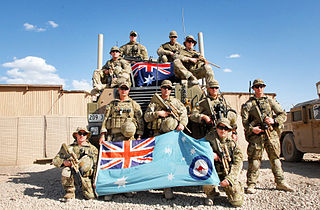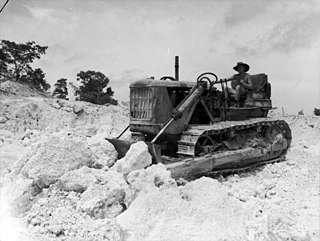Related Research Articles

The Royal Australian Air Force (RAAF) is the principal aerial warfare force of Australia, a part of the Australian Defence Force (ADF) along with the Royal Australian Navy and the Australian Army. Constitutionally the Governor-General of Australia is the de jure Commander-in-Chief of the Australian Defence Force. The Royal Australian Air Force is commanded by the Chief of Air Force (CAF), who is subordinate to the Chief of the Defence Force (CDF). The CAF is also directly responsible to the Minister for Defence, with the Department of Defence administering the ADF and the Air Force.

Airfield Defence Guards (ADG) are a mustering of the Royal Australian Air Force (RAAF) that are dedicated to the security and ground defence of airbases and other military aviation assets. Other duties include training other RAAF personnel, in skills such as the handling of small arms and infantry tactics. They do not, however, operate anti-aircraft artillery or missiles.

RAAF Base Richmond is a Royal Australian Air Force (RAAF) military air base located within the City of Hawkesbury, approximately 50 kilometres (31 mi) North-West of the Sydney Central Business District in New South Wales, Australia. Situated between the towns of Windsor and Richmond, the base is the oldest base in New South Wales and the second oldest in Australia. The base is home to the transport headquarters RAAF Air Lift Group, and its major operational formations, Nos. 84 and 86 Wings. The main aircraft type operated at the base is the Lockheed C-130 Hercules. Richmond is a regular venue for air shows and had at times been mooted as a site for Sydney's proposed second international airport.

RAAF Base Pearce is the main Royal Australian Air Force (RAAF) military air base in Western Australia, located in Bullsbrook, north of Perth. It is used for training by the RAAF and the Republic of Singapore Air Force.

No. 75 Squadron is a Royal Australian Air Force (RAAF) fighter unit based at RAAF Base Tindal in the Northern Territory. The squadron was formed in 1942 and saw extensive action in the South West Pacific theatre of World War II, operating P-40 Kittyhawks. It was disbanded in 1948, but reformed the following year and operated jet aircraft throughout the Cold War. The squadron was based at Malta from 1952 to 1954, flying de Havilland Vampires, and Malaysia from 1968 to 1983, with Dassault Mirage IIIs, before returning to Australia.

RAAF Base Tindal is a Royal Australian Air Force (RAAF) military air base and civil aviation airfield located 8 nautical miles east southeast of the town of Katherine, Northern Territory in Australia. The base is currently home to No. 75 Squadron and a number of non-flying units, and also hosts the civilian Katherine Tindal Airport. First constructed in 1942, it was refurbished in the late 1960s as a bare base capable of being utilised when required. It was opened as a permanently manned RAAF base in 1989.

RAAF Base Scherger is a Royal Australian Air Force (RAAF) military air base located approximately 26 km (16 mi) east of Weipa on the western side of Cape York Peninsula in Queensland, Australia. One of three bare bases in a chain of bases across Australia's top end, the base is occupied by a caretaker staff and can be activated at relatively short notice. The base was constructed by troops drawn mainly from the 17th Construction Squadron, in what is believed to have been the biggest project undertaken by the Royal Australian Engineers at the time.
RAAF Base Curtin, also sometimes RAAF Curtin is a joint use Royal Australian Air Force (RAAF) military air base and civil airport located 19 nautical miles southeast of the town of Derby, Western Australia. As it is one of the RAAF's three bare bases, no RAAF units are permanently based at Curtin and it is maintained by a small caretaker staff during peacetime.
RAAF Base Learmonth, also known as Learmonth Airport, is a joint use Royal Australian Air Force base and civil airport. It is located near the town of Exmouth on the north-west coast of Western Australia. RAAF Base Learmonth is one of the RAAF's three bare bases. No RAAF units are currently based at Learmonth and it is maintained by a small caretaker staff during peacetime.

Chief of Air Force (CAF) is the most senior appointment in the Royal Australian Air Force (RAAF), responsible to the Chief of the Defence Force (CDF) and the Secretary of the Department of Defence. The rank associated with the position is air marshal (three-star). The role encompasses "the delivery of aerospace capability, enhancing the Air Force's reputation and positioning the Air Force for the future". It does not include direction of air operations, which is the purview of the Air Commander Australia, a two-star position responsible directly to CDF in such circumstances but nominally reporting to CAF.

The Royal Australian Air Force's Air Combat Group (ACG) is the group which administers the RAAF's fighter and bomber aircraft. ACG was formed on 7 February 2002 by merging the RAAF's Tactical Fighter Group and Strike Reconnaissance Group in an attempt to improve the speed with which the RAAF can deploy its combat aircraft.

No. 78 Wing is a Royal Australian Air Force (RAAF) operational training wing, headquartered at RAAF Base Williamtown, New South Wales. It comprises Nos. 76 and 79 Squadrons, operating the BAE Hawk 127 lead-in fighter, and No. 278 Squadron, a technical training unit. No. 79 Squadron, located at RAAF Base Pearce, Western Australia, is responsible for converting new pilots to fast jets, while No. 76 Squadron at Williamtown conducts introductory fighter courses; both units also fly support missions for the Royal Australian Navy and the Australian Army.

No. 81 Wing is responsible for operating the Lockheed Martin F-35 Lightning II multi-role fighters of the Royal Australian Air Force (RAAF). Headquartered at RAAF Base Williamtown, New South Wales, the wing comprises three combat units, Nos. 3 and 77 Squadrons based at Williamtown and No. 75 Squadron at RAAF Base Tindal, Northern Territory, as well as an operational conversion unit at Williamtown. No. 81 Wing headquarters oversees squadron training in air-to-air and air-to-ground tactics, and support for the Australian Army and Royal Australian Navy. Tasked with offensive and defensive counter-air operations, the Hornets have been deployed to Diego Garcia in 2001–02, when they provided local air defence, to Iraq in 2003, when they saw action flying fighter escort and close air support missions in concert with Coalition forces, and to the Middle East in 2015–16, when they undertook strike operations during the military intervention against ISIL. They have also been employed to patrol high-profile events in Australia, including the Commonwealth Games and visits by foreign dignitaries.
No. 17 Squadron (17SQN), formerly 322 Expeditionary Combat Support Squadron (322ECSS) is a Royal Australian Air Force (RAAF) ground support squadron based at RAAF Base Tindal near Katherine, Northern Territory. In addition to providing support services at RAAF Tindal, it also has responsibilities for the three RAAF bare bases: RAAF Scherger near Weipa, Queensland, RAAF Curtin near Derby, Western Australia and RAAF Learmonth near Exmouth, Western Australia; and the Delamere Air Weapons Range.

Air Chief Marshal Sir Frederick Rudolph William Scherger, was a senior commander in the Royal Australian Air Force (RAAF). He served as Chief of the Air Staff, the RAAF's highest-ranking position, from 1957 until 1961, and as Chairman of the Chiefs of Staff Committee, forerunner of the role of Australia's Chief of the Defence Force, from 1961 until 1966. He was the first RAAF officer to hold the rank of air chief marshal.

Air Marshal Sir Valston Eldridge Hancock, was a senior commander in the Royal Australian Air Force (RAAF). He served as Chief of the Air Staff from 1961 to 1965. A graduate of the Royal Military College, Duntroon, Hancock transferred from the Army to the RAAF in 1929 and qualified as a pilot. His administrative training at Duntroon saw him mainly occupy staff posts, including Deputy Director of Operations and Intelligence at RAAF Headquarters from 1931 to 1935, and Director of Works and Buildings from 1937 to 1939. During the early years of World War II, he commanded No. 1 Bombing and Gunnery School, and held senior planning and administrative positions. He eventually saw combat in the Aitape–Wewak campaign of the Pacific War during 1945. Flying Bristol Beaufort light bombers, he led first No. 100 Squadron, and later No. 71 Wing. His actions earned him the Distinguished Flying Cross.
Air Marshal Selwyn David Evans AC, DSO, AFC was a senior commander of the Royal Australian Air Force (RAAF), and a writer and consultant on defence matters. He served as Chief of the Air Staff from 1982 until 1985. After leaving the RAAF he published two military treatises, A Fatal Rivalry: Australia's Defence at Risk and War: A Matter of Principles, as well as an autobiography.

Air Vice Marshal Allan Leslie Walters, CB, CBE, AFC was a senior commander in the Royal Australian Air Force (RAAF). Born in Victoria and raised in Western Australia, he graduated from the Royal Military College, Duntroon, before transferring to the RAAF in 1928. He was one of the service's leading flying instructors and aerobatic pilots between the wars, and was appointed to his first squadron command in 1937. Over the course of World War II, Walters led No. 1 Squadron in Singapore, No. 1 (Fighter) Wing in Darwin, Northern Territory, No. 72 Wing in Dutch New Guinea, and Northern Command in Papua New Guinea. He was decorated with the Air Force Cross in 1941 for his work with No. 1 Squadron, and mentioned in despatches in 1944 for his service with No. 72 Wing.

No. 5 Airfield Construction Squadron (5ACS) was a Royal Australian Air Force (RAAF) construction squadron. The unit was first formed in July 1942 and served in the New Guinea Campaign and Borneo Campaign during World War II. The squadron was one of only a few RAAF airfield construction units to be retained at the end of the war, and formed part of Australia's contribution to the occupation of Japan from 1945 until it was disbanded in June 1949. 5ACS was re-raised in August 1951 and worked on several RAAF airfields in Australia. It also provided small detachments of engineers to support RAAF deployments to South Vietnam and Thailand during the Vietnam War. The squadron was the RAAF's only airfield construction unit from 1961 onward, and was disbanded in December 1974.
References
- ↑ "Up and Away: RAAF Base Learmonth Reactivated in Record Time". Media release. Department of Defence. Retrieved 29 March 2013.
- ↑ "Bare base savings" (PDF). Air Force. 4 May 2012. p. 9. Retrieved 29 March 2013.
- ↑ Bree, Max (10 October 2013). "Team Effort in Townsville". Air Force. p. 10. Retrieved 8 October 2013.
- ↑ "RAAF Base Scherger". Royal Australian Air Force. Retrieved 29 March 2013.
- ↑ "RAAF Base Curtin". Royal Australian Air Force. Retrieved 29 March 2013.
- ↑ "RAAF Base Learmonth". Royal Australian Air Force. Retrieved 29 March 2013.
- ↑ "Tindal". RAAF Museum. Retrieved 29 March 2013.
